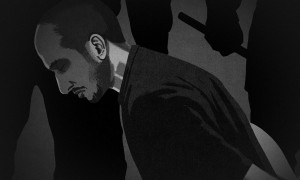Published in January, The Guantanamo Diary is an intense account of Mohamedou Ould Slahi’s excruciating experiences as a prisoner of the U.S. war on terror. Slahi was detained in his native Mauritania in 2001; a CIA rendition plane flew him to Jordan for brutal interrogation sessions, and from there he was taken to Afghanistan and then finally to the infamous Guantanamo prison camp. He has never been charged with any crimes.
Slahi’s diary was edited by NCAC board member, writer and human rights activist Larry Siems. But he was actually the diary’s second editor; the first was the U.S. government, which “added more than 2,500 black-bar redactions censoring Mohamedou’s text.”
We spoke with Siems about editing a censored text, and how the government’s censorship failed to blunt the impact of Slahi’s narrative.
The censorship of the text of the book is plainly clear, but what do we know about the process of writing and eventually disclosing the diaries that became this book?

Like everything in Guantanamo, those pages were taken to Washington and locked in a secure facility where they are accessible only to the attorneys who have top secret security clearance. They’re considered classified, like every other utterance from every other Guantanamo prisoner is just presumed classified from the moment that it’s created.
So it sat there, classified for almost seven years. During that time Nancy Hollander and her legal team conducted litigation and negotiation behind the scenes to get the book declassified and cleared for public release.
Finally in the summer of 2012, it had made that last hurdle of going through the last redaction process and they were able to hand the PDF of the document to me in its public, cleared form — which includes all redactions.
The process of editing the book at times seemed like an attempt to peek behind the 2,500 or so government redactions. What was that experience like?
It’s an interesting psychological phenomenon. When you put a black bar over something, the person who sees that black bar is compelled to think about what’s behind it, right? It’s an automatic reaction — especially when we’re talking about government secrets. Whenever we’re confronted with black boxes that have been imposed by our government, as citizens part of our duty should be thinking about what’s being withheld and why.
I made no effort to peer through the black bars or to uncover classified material or anything like that. I lined his account up against what was by 2012 a substantial trove of declassified government documents in the public realm that recounted his odyssey through this gulag of detention sites around the world. And it became clear immediately what an accurate historian of his own experience he is.
And then there are other redactions that aren’t plot-based, but are based on trying to obscure some of the emotional content. There is a place where they seem to redact the word “tears” when he says he cannot help breaking in [REDACTED]. And there are some attempts apparently to obscure the fact that some of the interrogators are women — they habitually try to redact the pronouns that refer to female interrogators — “her and she.”
And even the full text of a poem that he wrote is redacted. It’s impossible to try to read the minds of censors in any case, but did you ever try to imagine what the motivation might have been for some of these decisions?
What’s interesting is that censors are just human beings. This is a human being who’s sitting there with a literal or metaphorical Sharpie and drawing black lines through text. And like all of us, you make mistakes, you’re not consistent, you lose track of things, you might do some things impulsively. So in some sense it reflects the fact that even in the most bureaucratic of processes it really comes down to individuals who are assigned a task and have quirky individual responses to that task.
For me, the black boxes are kind of the fingerprints of a much larger censorship regime that’s been imposed on Mohamedou and his story for many years. When the manuscript was released in 2012, I think it was released in large part because so many documents had been released by that point that told the story of his abuse and torture that the government could no longer say that his experience itself — and his expression of his experience — was a state secret.


